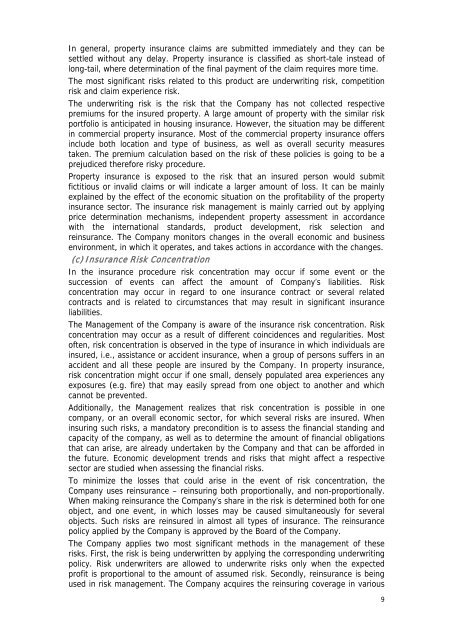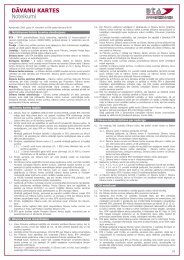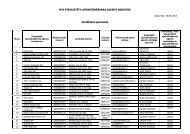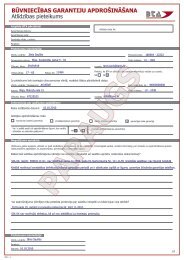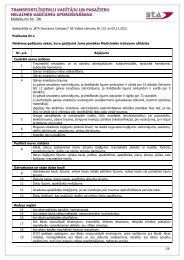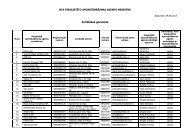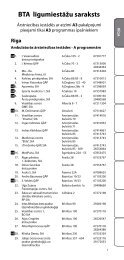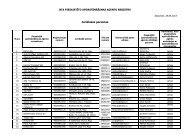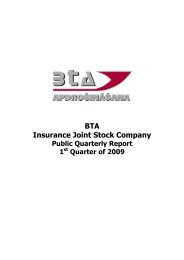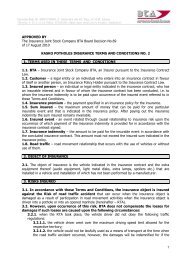BTA Insurance Joint Stock Company Public Quarterly Report 4 ...
BTA Insurance Joint Stock Company Public Quarterly Report 4 ...
BTA Insurance Joint Stock Company Public Quarterly Report 4 ...
You also want an ePaper? Increase the reach of your titles
YUMPU automatically turns print PDFs into web optimized ePapers that Google loves.
In general, property insurance claims are submitted immediately and they can be<br />
settled without any delay. Property insurance is classified as short-tale instead of<br />
long-tail, where determination of the final payment of the claim requires more time.<br />
The most significant risks related to this product are underwriting risk, competition<br />
risk and claim experience risk.<br />
The underwriting risk is the risk that the <strong>Company</strong> has not collected respective<br />
premiums for the insured property. A large amount of property with the similar risk<br />
portfolio is anticipated in housing insurance. However, the situation may be different<br />
in commercial property insurance. Most of the commercial property insurance offers<br />
include both location and type of business, as well as overall security measures<br />
taken. The premium calculation based on the risk of these policies is going to be a<br />
prejudiced therefore risky procedure.<br />
Property insurance is exposed to the risk that an insured person would submit<br />
fictitious or invalid claims or will indicate a larger amount of loss. It can be mainly<br />
explained by the effect of the economic situation on the profitability of the property<br />
insurance sector. The insurance risk management is mainly carried out by applying<br />
price determination mechanisms, independent property assessment in accordance<br />
with the international standards, product development, risk selection and<br />
reinsurance. The <strong>Company</strong> monitors changes in the overall economic and business<br />
environment, in which it operates, and takes actions in accordance with the changes.<br />
(c) <strong>Insurance</strong> Risk Concentration<br />
In the insurance procedure risk concentration may occur if some event or the<br />
succession of events can affect the amount of <strong>Company</strong>’s liabilities. Risk<br />
concentration may occur in regard to one insurance contract or several related<br />
contracts and is related to circumstances that may result in significant insurance<br />
liabilities.<br />
The Management of the <strong>Company</strong> is aware of the insurance risk concentration. Risk<br />
concentration may occur as a result of different coincidences and regularities. Most<br />
often, risk concentration is observed in the type of insurance in which individuals are<br />
insured, i.e., assistance or accident insurance, when a group of persons suffers in an<br />
accident and all these people are insured by the <strong>Company</strong>. In property insurance,<br />
risk concentration might occur if one small, densely populated area experiences any<br />
exposures (e.g. fire) that may easily spread from one object to another and which<br />
cannot be prevented.<br />
Additionally, the Management realizes that risk concentration is possible in one<br />
company, or an overall economic sector, for which several risks are insured. When<br />
insuring such risks, a mandatory precondition is to assess the financial standing and<br />
capacity of the company, as well as to determine the amount of financial obligations<br />
that can arise, are already undertaken by the <strong>Company</strong> and that can be afforded in<br />
the future. Economic development trends and risks that might affect a respective<br />
sector are studied when assessing the financial risks.<br />
To minimize the losses that could arise in the event of risk concentration, the<br />
<strong>Company</strong> uses reinsurance – reinsuring both proportionally, and non-proportionally.<br />
When making reinsurance the <strong>Company</strong>’s share in the risk is determined both for one<br />
object, and one event, in which losses may be caused simultaneously for several<br />
objects. Such risks are reinsured in almost all types of insurance. The reinsurance<br />
policy applied by the <strong>Company</strong> is approved by the Board of the <strong>Company</strong>.<br />
The <strong>Company</strong> applies two most significant methods in the management of these<br />
risks. First, the risk is being underwritten by applying the corresponding underwriting<br />
policy. Risk underwriters are allowed to underwrite risks only when the expected<br />
profit is proportional to the amount of assumed risk. Secondly, reinsurance is being<br />
used in risk management. The <strong>Company</strong> acquires the reinsuring coverage in various<br />
9


